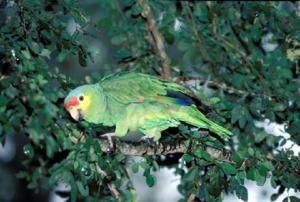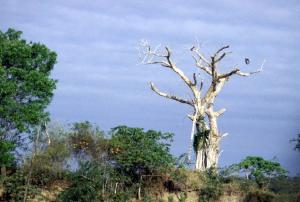
 Just back from our ecotour to amazon country, we are truly in awe of what we have been fortunate enough to see! A pair of Amazona oratrix (Double Yellow-headed Amazons) flew directly over as we began our first morning tour, giving new visitors a taste of the excitement to come. Oratrix always seem to be having so much fun out there in the big open sky, yodeling duets with their mates and squawking at others who dare to land on "their" branch. That first afternoon, we got to observe a group of nine fairly closely! Just back from our ecotour to amazon country, we are truly in awe of what we have been fortunate enough to see! A pair of Amazona oratrix (Double Yellow-headed Amazons) flew directly over as we began our first morning tour, giving new visitors a taste of the excitement to come. Oratrix always seem to be having so much fun out there in the big open sky, yodeling duets with their mates and squawking at others who dare to land on "their" branch. That first afternoon, we got to observe a group of nine fairly closely!
 Their zygodactyl toes make climbing up and down and just "hanging around" easy. These guys are great climbers and stretch and move in all directions, reaching for the next ripe fruit. All of us who have captive parrots come to the same conclusion when watching these wild amazon relatives: They live incredibly rich sensory lives! A section of my amazon parrot slide series is called, "What a Perch!" A dowel and a cement pedicure perch just don't measure up to the sun, wind, flower and vine-drenched Ebano tree tops, or the gnarled and sun-bleached snags that are loaded with woodpecker holes and epiphytic bromeliads. The green hills are speckled with pastures and forest. Exuberantly flowering vines climb and cover the tops of trees…fuschia bougainvillea and others not identified. Their zygodactyl toes make climbing up and down and just "hanging around" easy. These guys are great climbers and stretch and move in all directions, reaching for the next ripe fruit. All of us who have captive parrots come to the same conclusion when watching these wild amazon relatives: They live incredibly rich sensory lives! A section of my amazon parrot slide series is called, "What a Perch!" A dowel and a cement pedicure perch just don't measure up to the sun, wind, flower and vine-drenched Ebano tree tops, or the gnarled and sun-bleached snags that are loaded with woodpecker holes and epiphytic bromeliads. The green hills are speckled with pastures and forest. Exuberantly flowering vines climb and cover the tops of trees…fuschia bougainvillea and others not identified.
And oh my, the view! Off to the east, the mighty Atlantic Ocean Gulf Coast glistens in the background. We had afternoons on totally deserted beaches, and enjoyed picking through piles of shells limited only by our ability to carry them home! I have figured out why Amazons are never seen right out on the coast…they like their own voices too much to want to compete with relentless roar! Well, possibly, it's the relentless winds, and the lack of forest protection. A green guy could get predated pretty easily out there on the dunes! Speaking of predators, we saw an Indigo Snake slither off into the brush, as well as Coati Mundi, and amazing variety and numbers of hawks and falcons. We watched a peregrine falcon hunting over a pond, and all of the usual pond species went into hiding. We were lucky to have a great guide to the site, Arturo Caso, who is a scientist researching Ocelots, but who is also a raptor expert, and a former falconer. Like the cats and hawks that he studies, he has a great eye for seeing all of the wild details that a newcomer is likely to miss.
Amazona viridiginalis (Mexican red-headed, or Green-cheeked) is endemic to this area, and like other Amazons, endangered. When a species such as viridiginalis exists only in a small range, its future is especially fragile. If compromises threaten in just that small area, it means extinction. The northern edge of the territory of Amazona autumnalis (Red-lored) is Northeastern Tamaulipas, and we got a nice sighting of them, the third of the sympatric Amazona species of the area. And that was just the first day!
Least in size and last of the local parrot species sighted, we saw the smallest parrot there, Aratinga holochlora, (Green Parakeet, or, in the pet trade, the Green Conure). They race around in raucous groups, zipping in and out of view in the treetops. What fun it would be to join the flock, if even just for one day! They look like green gems flying in unison!
 Figs of the Strangler Fig tree are abundant. In the spring, the Amazons eat the giant green seeds from the very hard Ebano tree pods with gusto. By fall, the mature pods are brown and so hard that only the most powerful and determined can get them open. This is a skill passed on through the generations. Parents teach their "polluellos" how to unzip the tough strings down each side and pry the vice-gripped halves apart to find the tasty green seeds inside. I had to try one, and well, they actually taste a little like sunflower seeds, just a little more green and astringent.
Figs of the Strangler Fig tree are abundant. In the spring, the Amazons eat the giant green seeds from the very hard Ebano tree pods with gusto. By fall, the mature pods are brown and so hard that only the most powerful and determined can get them open. This is a skill passed on through the generations. Parents teach their "polluellos" how to unzip the tough strings down each side and pry the vice-gripped halves apart to find the tasty green seeds inside. I had to try one, and well, they actually taste a little like sunflower seeds, just a little more green and astringent.
After identifying 125 species of birds during the week, I was feeling a just a little disappointment that on our last afternoon trek we were seeing relatively little. But then, just like the fireworks finally on the Fourth of July, we came across a huge group of Amazons going loco in the forest! There were uncountable numbers…groups coming and going and having a blowout party! This time of year (post breeding season) the Amazons are less intensely defensive of their nest trees and territories, and gather in loose groups to socialize and rant and rave! Perhaps it was a coming together of a few different communities, because they were doing it up right! And such a treat to sit and enjoy them enjoying their ruckus!
[Fall 2000]
Join us for the next ecotour to Mexico!
|

